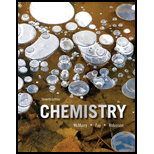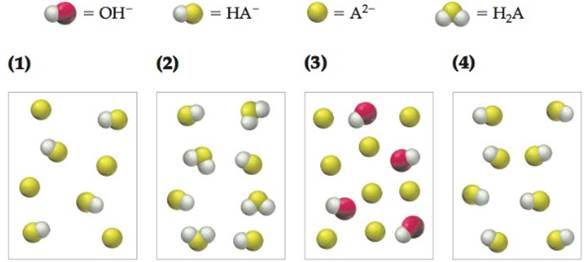
Concept explainers
The following pictures represent solutions at various stages in thetitration of a weak diprotic acid

(a) To which of the following stages do solutions 1—4 correspond?
(i) Halfway to the first equivalence point
(ii) At the first equivalence point
(lii) Halfway between the first and second equivalence points
(iv) Beyond the second equivalence point
(b) Which solution has the highest pH? Which has the lowestpH?
Learn your wayIncludes step-by-step video

Chapter 16 Solutions
Chemistry (7th Edition)
Additional Science Textbook Solutions
General, Organic, and Biological Chemistry (3rd Edition)
CHEMISTRY-TEXT
Chemistry: An Introduction to General, Organic, and Biological Chemistry (13th Edition)
Chemistry
Chemistry: A Molecular Approach (4th Edition)
Introductory Chemistry (5th Edition) (Standalone Book)
- Malic acid is a weak diprotic organic acid with Ka1 = 4.0 104 and Ka2 = 9.0 105. a Letting the symbol H2A represent malic acid, write the chemical equations that represent Ka1 and Ka2. Write the chemical equation that represents Ka1 Ka2. b Qualitatively describe the relative concentrations of H2A, HA, A2, and H3O+ in a solution that is about one molar in malic acid. c Calculate the pH of a 0.0175 M malic acid solution and the equilibrium concentration of [H2A]. d What is the A2 concentrationin in solutions b and c?arrow_forwardAmino acids are an important group of compounds. At low pH, both the carboxylic acid group (CO2H) and the amine group (NHR) are protonated. However, as the pH of the solution increases (say, by adding base), the carboxylic acid proton is removed, usually at a pH between 2 and 3. In a middle range of pHs, therefore, the amine group is protonated, but the carboxylic acid group has lost the proton. (This is called a zwitterion.) At more basic pH values, the amine proton is dissociated. What is the pH of a 0.20 M solution of alanine hydrochloride, [NH3CHCH3CO2H]Cl?arrow_forwardThe simplest amino acid is glycine, H2NCH2CO2H. The common feature of amino acids is that they contain the functional groups: an amine group, –NH2, and a carboxylic acid group, –CO2H. An amino acid can function aseither an acid or a base. For glycine, the acid strength of the carboxyl group is about the same as that of acetic acid, CH3CO2H, and the base strength of the amino group is slightly greater than that of ammonia, NH3.(a) Write the Lewis structures of the ions that form when glycine is dissolved in 1 M HCl and in 1 M KOH.(b) Write the Lewis structure of glycine when this amino acid is dissolved in water.arrow_forward
- Does pH (H+/OH-balance) affect the movement of Polident molecules in solutions? Does Polident contain acidic or basic ingredients? How will the Polident ingredients interacts with the H+/OH- balance in the different pH solutions?arrow_forwarda) A student prepares an 750.0 mL buffer solution with a pH of 4.85 by adding sodium acetate to a solution of acetic acid. However, they forgot to document the mass of NaC2H3O2 added to the beaker. Fortunatelly, they know that the concentration of HC2H3O2 is 0.235M. Determine the mass, in grams, of NaC2H3O2 that must have been added to the solution. (Molar Mass of NaC2H3O2=82.0343 g/mol) b) 10 mL is accidentally spilled into the buffer solution from part a. Determing the new pH of the solution.arrow_forwardA solution of vinegar is 0.763 M in acetic acid, C2H4O2(molar mass = 60 g mol-1). The density of vinegar is 1.004 g/mL. What is the molal concentration of acetic acid? Phenols, HOC6H5 are weakly acidic, and in aqueous solution an equilibrium exists between the phenol and the phenoxide ion. Ka for HOC6H5 = 1.6 ×10-10. What is the optimal pH for phenol buffers? Consider 1.0 L of a solution that is 0.85 M HOC6H5 and 0.80 M NaOC6H5. Calculate the pH of this solution. Calculate the pH after 0.10 mole of HCl has been added to the part (b) solution. Assume no volume change on addition of HCl. (a) The Ka of benzoic acid (C6H5CO2H,molar mass = 122 g·mol-1) is 6.46×10-5. A solution is prepared by dissolving 6.1 g benzoic acid in enough water to make 1.0 L of solution. Calculate [C6H5CO2H], [C6H5CO2–], [H+], [OH–], the pH and the percent ionization of this solution. Sodium benzoate (NaC7H5O2) is used as a food preservative. What is the ratio of the concentration of…arrow_forward
- 2. The ionization constant for acetic acid is 1.8 x 10-5. How many grams of NaC2H3O2 must be added to one liter of a 0.20 M solution of HC2H3O2 to maintain a hydrogen ion concentration of 6.5 x 10-5 M?arrow_forwardHow many mL of a 5.0-M solution of sodium borate must be added to a 200-mL solution of 50 mM boric acid in order for the pH to be 9.6?arrow_forwardPyruvic acid is formed in the body from carbohydrate metabolism. In muscles, it is reduced to lactic acid in the course of exertion. The acid-dissociation constant for pyruvic acid is 3.2 * 10-3. Would you expect pyruvic acid to exist primarily as the neutral acid or as dissociated ions in muscle tissue, assuming a pH of 7.4 and an initial acid concentration of 2 * 10-4 M?arrow_forward
- When 25.0 mL of 0.200 M hydroiodic acid and 25.0 mL of 0.200 M ammonia are combined, the pH of the resulting solution will be : ..... fill in the blank 1A. Less than 7B. Equal to 7C. Greater than 7arrow_forwardWhen 35 mL of 0.20 M acetic acid and 35 mL of 0.10 M calcium hydroxide are combined, the pH of the resulting solution will be : ..... A. Less than 7B. Equal to 7C. Greater than 7arrow_forwardA 0.025 M solution of an unknown organic acid has a pH of 3.23. 2.1 By means of a full calculation, determine the value of the ionisation constant of the conjugatebase of this acid..- You may use “HA” to denote the formula of the acid.- You may make certain assumptions to simplify your calculations2.2 A certain amount of the sodium salt of the conjugate base of the acid was added to the system.Will the pH of the resulting solution increase or decrease, compared to the original given value? Explain your answer in a short sentence or two.arrow_forward
 Chemistry & Chemical ReactivityChemistryISBN:9781133949640Author:John C. Kotz, Paul M. Treichel, John Townsend, David TreichelPublisher:Cengage Learning
Chemistry & Chemical ReactivityChemistryISBN:9781133949640Author:John C. Kotz, Paul M. Treichel, John Townsend, David TreichelPublisher:Cengage Learning Chemistry & Chemical ReactivityChemistryISBN:9781337399074Author:John C. Kotz, Paul M. Treichel, John Townsend, David TreichelPublisher:Cengage Learning
Chemistry & Chemical ReactivityChemistryISBN:9781337399074Author:John C. Kotz, Paul M. Treichel, John Townsend, David TreichelPublisher:Cengage Learning Chemistry: Principles and PracticeChemistryISBN:9780534420123Author:Daniel L. Reger, Scott R. Goode, David W. Ball, Edward MercerPublisher:Cengage Learning
Chemistry: Principles and PracticeChemistryISBN:9780534420123Author:Daniel L. Reger, Scott R. Goode, David W. Ball, Edward MercerPublisher:Cengage Learning General Chemistry - Standalone book (MindTap Cour...ChemistryISBN:9781305580343Author:Steven D. Gammon, Ebbing, Darrell Ebbing, Steven D., Darrell; Gammon, Darrell Ebbing; Steven D. Gammon, Darrell D.; Gammon, Ebbing; Steven D. Gammon; DarrellPublisher:Cengage Learning
General Chemistry - Standalone book (MindTap Cour...ChemistryISBN:9781305580343Author:Steven D. Gammon, Ebbing, Darrell Ebbing, Steven D., Darrell; Gammon, Darrell Ebbing; Steven D. Gammon, Darrell D.; Gammon, Ebbing; Steven D. Gammon; DarrellPublisher:Cengage Learning



